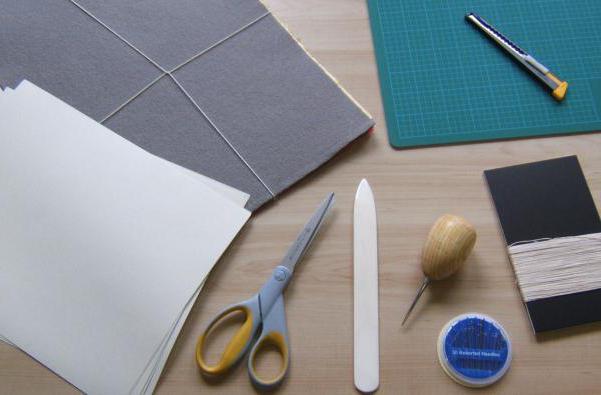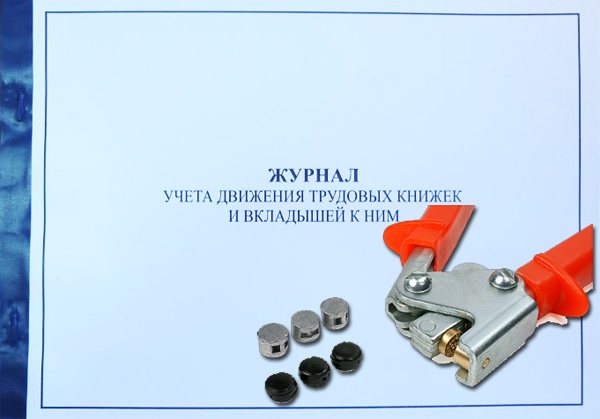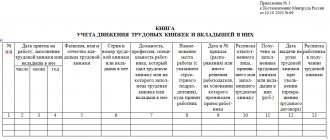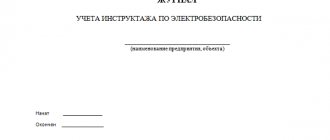Rules of law
A work book is the most important document of an employee, the safety of which is controlled by the employer.
By law, if a company has at least one hired employee, it is necessary to keep a log of work records. This is a legal requirement, which is stated in the rules for maintaining and storing TC. Moreover, such a record book must be sealed in accordance with the law. This is a document of increased accountability, therefore, its appearance and sealing, in particular, should be treated with extreme care. This measure helps protect the journal from external interference in order to make adjustments to existing records. Sealing (protection) of the work record book is an important aspect of the HR officer’s activity. This document is always checked during scheduled visits by specialists from the State Labor Inspectorate. Disadvantages in the design of such forms are discovered very often.
There are certain requirements regarding the appearance and size of the magazine, including:
- The book must be in A-4 format.
- Its volume (number of sheets) should be such that it is enough for at least 2-3 years.
- Thick cover. It is needed because the work record book is used for a long period, and is stored in the archive for even longer.
- The layout of the pages should be such that all the necessary data can be entered.
Other important requirements for the book of accounting for the movement of work books and inserts in them:
- The journal must be signed personally by the manager.
- Each sheet is hand numbered by an authorized employee.
- The book must be stitched and sealed.
If at least one of these requirements is not met, this will lead to the imposition of penalties on the employer.
Everything you need to know about magazine firmware

Before flashing a magazine, you need to familiarize yourself with the legal requirements regarding this process. The first stage is its weaving, which is necessary if the magazine is thin. Its thickness may be enough for many more records, but if the cover wears out, it can no longer be used. As a result, after each inspection a fine awaits.
The next step is filling out the title page. According to the rules, you must number the pages. The order of this is extremely simple - end-to-end, that is, each subsequent page has a number one more than the previous one - 1, 2, 3, 4, 5, etc. A failure in numbering or a number of pages less than stated is also a fine for the manager.
Filling out the title page
We write the name of the object correctly - with permission for construction or reconstruction. If they are not there (for example, during a major overhaul), we write the name of the object from the contract. Next, we collect copies of orders appointing responsible persons of the Developer, Customer, General Contractor, Subcontractor. We ask each of them to sign in the “signature” column. At the same time, we are collecting the details of all these organizations (you can just ask the responsible persons). Whether you have a printed magazine or a homemade one, you need to stitch it, number the sheets and seal it with the Customer’s seal. The number of pages is also indicated on the title page.
Materials for firmware

In order to lace a book, which is also a mandatory requirement, you need:
- An awl is a very strong knitting needle with a pointed end. Something like a thick needle without an eye. Due to the comfortable handle, it is possible to penetrate the thickness of the paper in almost one movement.
- Threads (twine) used to stitch the magazine. They must be strong, but at the same time flexible. Excellent solution LSh-20. This thread is strong and soft, and is easy to work with when stitching documents. Sometimes, due to lack of resources, they stitch the magazine with ordinary thread No. 10, but this is not very convenient and not very durable, so it is better to buy suitable ones once. In addition, such threads easily tear the paper, which is a violation in itself.
- Needle, crochet hook - for threading.
- Possibly a hole punch, but they need to penetrate the entire thickness of the magazine and the cover.
In order to make the tip of the thread more rigid, you can lubricate it with nail polish or office glue. After completing the process, be sure to cut off this section of the thread.
Choosing a magazine
Clause 7 of RD 11-05-2007 states that the magazine is printed in A4 format. That is, it means that the magazine must be purchased ready-made in a store. This is convenient for the construction of large facilities and is mandatory for facilities supervised by the inspection of the State Construction Supervision (IGSN) or the Federal Service for Environmental, Technological and Nuclear Supervision (Rostechnadzor). If the object itself is small (short construction period) and registration with IGSN and Rostechnazor is not required, then, by agreement with the Customer, the magazine can be printed on a printer. On sale I have seen printed A4 magazines about 6mm thick with a cardboard cover and about 14mm thick with binding and hard backs like a good book. At the beginning of the journal, “Appendix No. 1 to RD-11-05-2007” is indicated.
Stitching order

There are clear regulations on how the firmware for the registration and accounting log should look. In order to comply with everything, you need to follow this algorithm:
- Sewn on the left side of the magazine margin.
- To do this, there must be 3 holes at an equal distance from one another relative to the middle of the sheet. There is no standard for the distance, but experienced personnel officers recommend making it within 5-7 cm from the central hole.
- The thread is started from the back and pulled forward through the outer holes.
- Now you need to align and connect them, thread them through the central hole and pull them out onto the front of the cover from the back.
- If the thread is thin (for example, No. 10), then this process must be repeated several times. In this case, each “circle” should be checked for the evenness of the thread and its shape.
- The last stage is tying the threads into a knot. When tying, you also need to grab the central thread.
How to stitch documents correctly
Having figured out how to stitch documents with 3 holes, it won’t be too difficult for you to connect papers with 4 holes. The process is almost the same as the previous option, only the distance between adjacent holes should be about 1.5 cm.
The piece of paper indicates the number of pages in the document and notes the data of the specialist who certified it (full name and signature). This is the simplest answer to the question of how to properly stitch documents with threads, and more complex and frequently used combinations are presented in the photo below.
Design of a sheet for fastening threads

In order to prepare the magazine for sealing, you need to perform one more stage of work - glue the threads to the magazine. This process has a number of features. Execution order:
- Pull the threads tightly.
- Fold over the edge of the cover.
- Glue. The gluing itself is carried out using a piece of paper designed in a certain way.
Form for gluing:
- Cut out a square measuring 8x8 cm from regular office paper.
- Write the phrase “the magazine is stitched”, be sure to indicate the date using Arabic numerals.
- Get the manager's signature on it.
- Glue the sheet to the inside back of the magazine by passing a thread through it. Do not trim the edge either.
- Place the organization's seal so that it appears on both the glued sheet and the journal sheet. This point is important, because such protection will allow you to immediately see whether any actions were taken with the primary filling.
This sheet is an important element of subsequent filling.
How to correctly flash documents before submitting them to the archives or the tax office
- Document's name.
- Filing date.
- Shelf life.
- Annotation (that is, an explanation of what is contained in the document and why it needs to be stored).
- A list of all documents included in the binder, indicating the pages in each document.
- Data of the responsible person - the compiler of the file.
- Sheets should be numbered, not pages. In this case, the pages of the document may have their own numbering, different from the newly affixed one.
- The numbers are placed in the upper right corner, and the number should not touch the text of the document.
- If the case contains attachments to documents, they are numbered in general order immediately after this document.
- If there are letters in the file, then first you need to number the envelope, and then all the sheets enclosed in it.
- If there are several volumes in the case, then they need to be numbered separately.
- If the appendices to the case are separated into a separate volume, then they should also be numbered separately.
- Large format sheets are numbered in the upper right corner, folded and hemmed under one edge.
- If the sheet contains several fragments (for example, checks), then it is necessary to make an inventory of the contents of the sheet, and number the sheet in a general order.
- If the file contains glued notes, they must be numbered in a general order, and the inventory must indicate how many sheets are contained in the glued together.
We recommend reading: Benefits for military personnel on utility bills
Sealing
Actually, this is the key process in the design of the magazine, and it was for its implementation that the above actions were carried out. The filling can be done using sealing wax or another seal. The main task of the selected tool is to block the possibility of interference in the recording.
Types of fillings

They are power and control. Each of these types has its own purpose. Lead ones are called power ones, because to remove them you need to use significant force. These are used for sealing the accounting and movement log in exceptional situations.
For such a case, a control seal is convenient; it is similar to wax and lead, but does not have the same resistance force. Its main task is to detect the fact of interference with the integrity of the log.
There are types of seals available that can be used to seal a ledger, including:
- Sticker seals. They are glued only once; if you try to tear them off, an inscription appears on it indicating interference.
- Warranty label. When you try to peel them off, they are destroyed, which is impossible not to notice.
- Tape seal. It is glued only once; if it is peeled off, the backing layer will become unusable.
The simplest solution is to seal the edges of the thread with a piece of paper and indicate the date of filling.
Seal details
Regardless of the type of filling used, it must contain the following features:
- An identification number.
- It must be disposable, without the possibility of any reuse.
- Be protected from access by forceful holding.
Step-by-step instructions: how to seal a magazine?
To seal or seal the magazine you will need:
- impression and sealing wax;
- film number seal;
- filling made of a different material.
For sealing, an impression is required, which is quite difficult to produce and requires certain costs and sealing wax. If you want to use this method of protection, which has been used for a long time, then you need:
- Melt a small amount of sealing wax.
- Carefully pour hot sealing wax onto the inside of the magazine cover in the place where the thread is secured to the sheet that was used to glue it to the cover.
- Place an impression on the wax that has not cooled down.
- Allow to cool, after which you can use.
It must be taken into account that a typo can be made inaccurately due to lack of experience and dexterity . Therefore, first try to practice on a blank sheet of paper. In addition, the wax seal may crumble before you finish using the magazine, which will lead to its unsuitable appearance.
Modern fillings are highly durable products, the fixation of which does not require much effort from you. For people who frequently perform fillings, it is advisable to have a sealer that can be used to place any fillings.
To do this, you need to take this tool, which resembles forceps, hold the ends of two threads and the material included with the kit in it simultaneously, and secure the seal. This device is easy to use.
The most budget options for fillings that can be used instead of wax seals:
- Sticker seals that you just need to stick on according to the instructions and smooth out. When you try to open it, an inscription appears on it indicating the fact of intervention.
- Warranty labels that can be simply affixed in accordance with the instructions. If opened unauthorized, they almost completely crumble.
- The adhesive seal is simply glued using the adhesive tape technology. When you try to open it, the top layer becomes unusable.
If you like to make various exclusive things with your own hands, or you can simply make a filling for free from scrap material, attach it to the tip of two threads folded together. Enter the number.
Upon completion of the sealing, a commission of at least three people must be assembled to draw up a report. Having drawn up the act, put it in the folder with local nomenclature documents.
the seal number on the inside of the magazine , have the employer sign and seal it.
Persons responsible for the magazine

An authorized employee of the HR department is responsible for all the above manipulations with the magazine and its safety. If the company is small, then directly the manager, secretary, accountant. An order is issued to grant a specific employee the authority to work with the journal. If castling occurs and another person is responsible for the accounting book, then a new order must be issued and documents are transferred. Confirmation that everything went legally will be the acceptance certificate. It must indicate:
- Information about the manager.
- Company details.
- The exact number and composition of documents to be transferred.
How to stitch documents correctly with thread so that everything is in accordance with GOST
- Proper preparation of documents is a painstaking and difficult task. After all, the final result of their consideration in institutions and the associated consequences largely depend on almost every letter and comma.
- Despite the fact that today there are many guides on the Internet on how to correctly fill out, compose and structure documents, it is unlikely that you will find complete and detailed instructions on how to flash them anywhere. From our point of view, the correct firmware of the document is no less important than all other stages of its preparation for the reasons given below.
The application to the tax office is usually completed by a notary. Why is this necessary? Firmware of documents is needed so as not to sign each sheet of the document separately. That is, the firmware must ensure that it is impossible to “disassemble” the sheets in this document (remove, insert, replace) without violating the integrity of the firmware.









